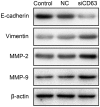Decreased expression of CD63 tetraspanin protein predicts elevated malignant potential in human esophageal cancer
- PMID: 28599425
- PMCID: PMC5453118
- DOI: 10.3892/ol.2017.6023
Decreased expression of CD63 tetraspanin protein predicts elevated malignant potential in human esophageal cancer
Abstract
The tetraspanin CD63 has been described to have critical roles in multiple biological processes, including tumorigenesis and metastasis in several types of cancer. However, its role in esophageal carcinoma (EC) has not been reported. In the current study, immunohistochemistry was used to investigate CD63 expression in 106 esophageal cancer samples, 49 adjacent esophagus tissues and 17 normal esophagus mucosa tissues. The results revealed that the overexpression of CD63 was observed in esophageal cancer samples and negatively correlated with tumor stage and lymph node metastasis. To further evaluate the role of CD63 in esophageal carcinoma, the invasiveness of EC cells was analyzed using matrigel invasion assays and wound healing assays in vitro. Furthermore, it was found that CD63 knockdown increased the invasiveness of TE-1 cells through the upregulation of matrix metalloproteinase (MMP) expression via promoting epithelial-mesenchymal transition. The current data therefore suggested that low levels of CD63 expression may be involved in the tumor progression of esophageal carcinoma.
Keywords: epithelial-mesenchymal transition; esophageal carcinoma; invasiveness; lymph nodes metastasis; tetraspanin CD63; tumor stage.
Figures





Similar articles
-
CD63 inhibits the cell migration and invasion ability of tongue squamous cell carcinoma.Oncol Lett. 2018 Jun;15(6):9033-9042. doi: 10.3892/ol.2018.8499. Epub 2018 Apr 16. Oncol Lett. 2018. PMID: 29844819 Free PMC article.
-
TIM-3 promotes the metastasis of esophageal squamous cell carcinoma by targeting epithelial-mesenchymal transition via the Akt/GSK-3β/Snail signaling pathway.Oncol Rep. 2016 Sep;36(3):1551-61. doi: 10.3892/or.2016.4938. Epub 2016 Jul 14. Oncol Rep. 2016. PMID: 27430162
-
Tetraspanin CD63 acts as a pro-metastatic factor via β-catenin stabilization.Int J Cancer. 2015 May 15;136(10):2304-15. doi: 10.1002/ijc.29296. Epub 2014 Nov 11. Int J Cancer. 2015. PMID: 25354204
-
Overexpression of CD9 correlates with tumor stage and lymph node metastasis in esophageal squamous cell carcinoma.Int J Clin Exp Pathol. 2015 Mar 1;8(3):3054-61. eCollection 2015. Int J Clin Exp Pathol. 2015. PMID: 26045817 Free PMC article.
-
Pancreatic Premalignant Lesions Secrete Tissue Inhibitor of Metalloproteinases-1, Which Activates Hepatic Stellate Cells Via CD63 Signaling to Create a Premetastatic Niche in the Liver.Gastroenterology. 2016 Nov;151(5):1011-1024.e7. doi: 10.1053/j.gastro.2016.07.043. Epub 2016 Aug 6. Gastroenterology. 2016. PMID: 27506299
Cited by
-
Multiplexed profiling of single-cell extracellular vesicles secretion.Proc Natl Acad Sci U S A. 2019 Mar 26;116(13):5979-5984. doi: 10.1073/pnas.1814348116. Epub 2019 Mar 11. Proc Natl Acad Sci U S A. 2019. PMID: 30858327 Free PMC article.
-
The predictive and prognostic role of a novel ADS score in esophageal squamous cell carcinoma patients undergoing esophagectomy.Cancer Cell Int. 2018 Oct 3;18:153. doi: 10.1186/s12935-018-0648-2. eCollection 2018. Cancer Cell Int. 2018. PMID: 30305803 Free PMC article.
-
Transcriptome analysis of clock disrupted cancer cells reveals differential alternative splicing of cancer hallmarks genes.NPJ Syst Biol Appl. 2022 May 12;8(1):17. doi: 10.1038/s41540-022-00225-w. NPJ Syst Biol Appl. 2022. PMID: 35552415 Free PMC article.
-
Analysis of the coding sequences of clownfish reveals molecular convergence in the evolution of lifespan.BMC Evol Biol. 2019 Apr 11;19(1):89. doi: 10.1186/s12862-019-1409-0. BMC Evol Biol. 2019. PMID: 30975078 Free PMC article.
-
Extracellular Vesicles as Signal Carriers in Malignant Thyroid Tumors?Int J Mol Sci. 2022 Mar 17;23(6):3262. doi: 10.3390/ijms23063262. Int J Mol Sci. 2022. PMID: 35328683 Free PMC article.
References
-
- Dipetrillo T, Suntharalingam M, Ng T, Fontaine J, Horiba N, Oldenburg N, Perez K, Birnbaum A, Battafarano R, Burrows W, Safran H. Neoadjuvant paclitaxel poliglumex, cisplatin, and radiation for esophageal cancer: A phase 2 trial. Am J Clin Oncol. 2012;35:64–67. doi: 10.1097/COC.0b013e318201a126. - DOI - PubMed
-
- van Hagen P, Hulshof MC, van Lanschot JJ, Steyerberg EW, van Berge Henegouwen MI, Wijnhoven BP, Richel DJ, Nieuwenhuijzen GA, Hospers GA, Bonenkamp JJ, et al. Preoperative chemoradiotherapy for esophageal or junctional cancer. N Engl J Med. 2012;366:2074–2084. doi: 10.1056/NEJMoa1112088. - DOI - PubMed
LinkOut - more resources
Full Text Sources
Other Literature Sources
Miscellaneous
